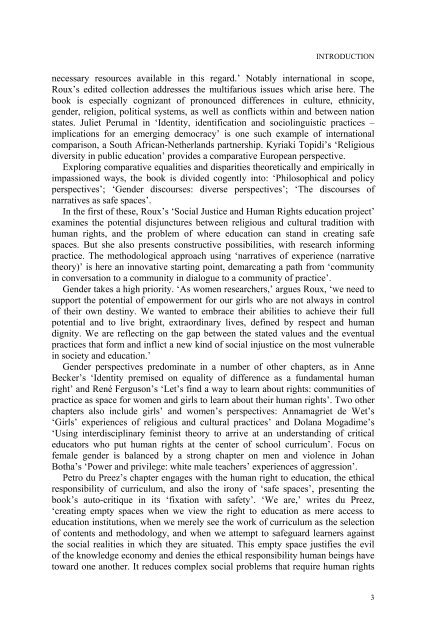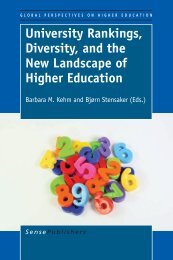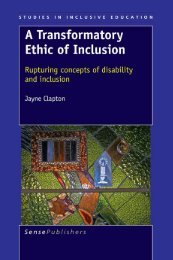Safe Spaces Human Rights Education in Diverse Contexts
Safe Spaces Human Rights Education in Diverse Contexts
Safe Spaces Human Rights Education in Diverse Contexts
Create successful ePaper yourself
Turn your PDF publications into a flip-book with our unique Google optimized e-Paper software.
INTRODUCTION<br />
necessary resources available <strong>in</strong> this regard.’ Notably <strong>in</strong>ternational <strong>in</strong> scope,<br />
Roux’s edited collection addresses the multifarious issues which arise here. The<br />
book is especially cognizant of pronounced differences <strong>in</strong> culture, ethnicity,<br />
gender, religion, political systems, as well as conflicts with<strong>in</strong> and between nation<br />
states. Juliet Perumal <strong>in</strong> ‘Identity, identification and sociol<strong>in</strong>guistic practices –<br />
implications for an emerg<strong>in</strong>g democracy’ is one such example of <strong>in</strong>ternational<br />
comparison, a South African-Netherlands partnership. Kyriaki Topidi’s ‘Religious<br />
diversity <strong>in</strong> public education’ provides a comparative European perspective.<br />
Explor<strong>in</strong>g comparative equalities and disparities theoretically and empirically <strong>in</strong><br />
impassioned ways, the book is divided cogently <strong>in</strong>to: ‘Philosophical and policy<br />
perspectives’; ‘Gender discourses: diverse perspectives’; ‘The discourses of<br />
narratives as safe spaces’.<br />
In the first of these, Roux’s ‘Social Justice and <strong>Human</strong> <strong>Rights</strong> education project’<br />
exam<strong>in</strong>es the potential disjunctures between religious and cultural tradition with<br />
human rights, and the problem of where education can stand <strong>in</strong> creat<strong>in</strong>g safe<br />
spaces. But she also presents constructive possibilities, with research <strong>in</strong>form<strong>in</strong>g<br />
practice. The methodological approach us<strong>in</strong>g ‘narratives of experience (narrative<br />
theory)’ is here an <strong>in</strong>novative start<strong>in</strong>g po<strong>in</strong>t, demarcat<strong>in</strong>g a path from ‘community<br />
<strong>in</strong> conversation to a community <strong>in</strong> dialogue to a community of practice’.<br />
Gender takes a high priority. ‘As women researchers,’ argues Roux, ‘we need to<br />
support the potential of empowerment for our girls who are not always <strong>in</strong> control<br />
of their own dest<strong>in</strong>y. We wanted to embrace their abilities to achieve their full<br />
potential and to live bright, extraord<strong>in</strong>ary lives, def<strong>in</strong>ed by respect and human<br />
dignity. We are reflect<strong>in</strong>g on the gap between the stated values and the eventual<br />
practices that form and <strong>in</strong>flict a new k<strong>in</strong>d of social <strong>in</strong>justice on the most vulnerable<br />
<strong>in</strong> society and education.’<br />
Gender perspectives predom<strong>in</strong>ate <strong>in</strong> a number of other chapters, as <strong>in</strong> Anne<br />
Becker’s ‘Identity premised on equality of difference as a fundamental human<br />
right’ and René Ferguson’s ‘Let’s f<strong>in</strong>d a way to learn about rights: communities of<br />
practice as space for women and girls to learn about their human rights’. Two other<br />
chapters also <strong>in</strong>clude girls’ and women’s perspectives: Annamagriet de Wet’s<br />
‘Girls’ experiences of religious and cultural practices’ and Dolana Mogadime’s<br />
‘Us<strong>in</strong>g <strong>in</strong>terdiscipl<strong>in</strong>ary fem<strong>in</strong>ist theory to arrive at an understand<strong>in</strong>g of critical<br />
educators who put human rights at the center of school curriculum’. Focus on<br />
female gender is balanced by a strong chapter on men and violence <strong>in</strong> Johan<br />
Botha’s ‘Power and privilege: white male teachers’ experiences of aggression’.<br />
Petro du Preez’s chapter engages with the human right to education, the ethical<br />
responsibility of curriculum, and also the irony of ‘safe spaces’, present<strong>in</strong>g the<br />
book’s auto-critique <strong>in</strong> its ‘fixation with safety’. ‘We are,’ writes du Preez,<br />
‘creat<strong>in</strong>g empty spaces when we view the right to education as mere access to<br />
education <strong>in</strong>stitutions, when we merely see the work of curriculum as the selection<br />
of contents and methodology, and when we attempt to safeguard learners aga<strong>in</strong>st<br />
the social realities <strong>in</strong> which they are situated. This empty space justifies the evil<br />
of the knowledge economy and denies the ethical responsibility human be<strong>in</strong>gs have<br />
toward one another. It reduces complex social problems that require human rights<br />
3














